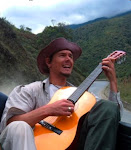so i am finally getting back to you all after a couple of travel days and a look at my species lists.
class is over--on my own and on the coast now---but i will save the details for another installment of travelblab
some high lights plant wise from the tiputini research station;
-wild papaya--^^jacaranda,^^
-huge canopy trees in the polygonaceae (buckwheat and rhubarb family)--never seen anything like that--polygons all the way down to the scarious, sheathing stipules, just huge trees.
-ananas--super fibrous wild papaya (bromeliaceae) that made some impressive twine on my first attempts.
-blooming bright red passion flower vines
-plants that sting but are used for pain--ala nettles---´´ortiga´´
quiet riot just came on the radio for those of you who care--´´come on feel the noise.....´´--the 80s are quite popular here--from pop to metal (a definate tangent)
-brownea--a large red flowered tree in the mimosaceae (fabales--legume) that apparently is quite an effective contraceptive (no personal experience) with potential sterility on overdose
-the white latex from the roots of the clarisia rasemosa (moraceae) is used for boils and other eruptive conditions including killing the parasitic botfly larvea that can be injected by mosquito bite
lots of palms including the ´walking palm´´ (socratea) whose extensive adventitious roots, systematically die and regenerate on opposite sides of the tree. motility or illusion¿?¿
got to spend about 20 hours 30 meters up in a canopy walkway that ran between 4 trees working on an epiphyte survey project.
(reminiscent of the ewok villages of northwest forest defense---a tactic that would be useless down here where the cargo helicopters overhead go where they please in the quest for more oil. and death threats are not uncommon against folks like the manager of the research station for little more than monitering activity)
great place to hang out though--watch the ants!
project results;
more lichens in the canopy
more plants in every group (moss, ferns, and flowering plants) in the understory
more total cover in the canopy (inc lichens)
the flowering plants in the canopy cansistently displayed significant drought adaptation--ie. thick leaves, succulence, or in the case of the tank bromieliads-- the ability to collect and store water.
----the dualling abiotic pressures of water and light in dynamic dance....
swimming with caiman, pirhana, sting ray, electric eels, anaconda, and a little parisitic fish that apparently can clog your urethra. no mishaps though.
next spot was a lodge off of the napo river (one of 17 major tributaries of the amazon) that was run by a quichua community. this was kind of wind down time as far as the course went--although the lagoon full of huge caiman was a highlight.
unsuccessful pirhana fishing.
the lagoon also afforded enough of an opening in the jungle to appreciate a very dark sky teeming with stars i may have never seen before.
fewer mammals than at tiputini (the research station)
a few species of heron----which are apparently the tropical water bird of evolutionary choice, their non-intensive foraging techniques make them better adapted to the relatively nutrient poor tropical waters than ducks (only 1 sp. in ecuador).
the now familiar toucans and parrots
a few howler monkeys
a pigmy king fisher
two species of blooming water hyacinth
soccer game with the local quichua community-----
little kids running circles around us wearing one cleat and one rubber boot, some played bare foot, some in socks.
i wore rubber boots on both feet just to see what it was like, and i can attest to the fact that sprinting in rubber boots in the blazing midday jungle sun is definately enough to make you sweat. they also dont stay on so well when you kick the ball.
so the last night at Sani lodge on the Napo we heard a series of inexplicable
explosions. The next day, we were speculating on what we had heard and settled on seismic testing. Why in the middle of the night?
the next day upon our arrival back in ??civilization?? with its acompanyingg news media, we discovered that the booming sounds that we had heard were in fact the sounds of major volcanic eruptions comming from tungurahua (5029m), that was in the process of burying the town of Banos with ash.
the andes high as they are, are still growing.
even the solid earth is teeming with ´life´´
para la vida
t






No hay comentarios:
Publicar un comentario